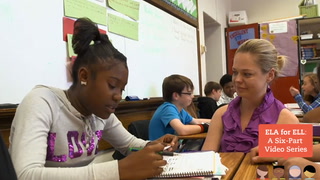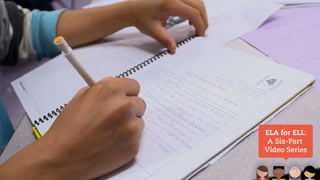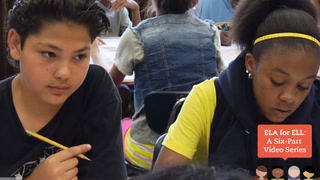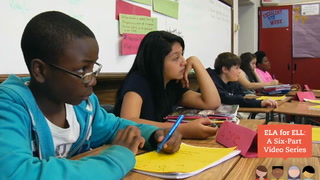Interacting with Complex Texts: Jigsaw Project Final Program Transcript
Langlois: Can someone please review for me what we talked about at the end of class yesterday? What did we finish with? Jaliel, can you tell me what we were doing?
Student: The ethos, logos and pathos.
Langlois: Okay. Ethos, pathos, and logos. So what are those things, though? Ethos, pathos, and logos? What are those in general?
Langlois (INT): My name is Katie Langlois, uh, we're at Morey MIddle School and I teach seventh grade.
Langlois: What do you think AJ?
Student: Maybe like ways of writing or advertising…
Langlois: Ways of writing, ways of advertising.
Student: Presenting.
Langlois: Ways of presenting.
Langlois (INT): My class is very, very heterogeneous. Their backgrounds are really different and often times those kids are English language learners but they all work together really well.
Aida Walqui: Many times teachers think, uh, that students need to be grouped homogeneously, and in fact, a lot of work with english language learners is predicated that way. And, that really runs counter to what we know about second language development. Second language development works best when you have groups that are heterogeneous, because that allows teachers to both sometimes group students in more homogeneous ways, and sometimes group them in more heterogeneous ways. . So in the video, you see that there are not only english language learners, but there are some speakers of African American vernacular english. And so, in both cases, and even in the case of Anglo students, uh, there is the opportunity to pull differential strength together for the benefit of the joint work.
Langlois: Now there are three different speeches that you guys are going to be reading. One speech is I Have a Dream by Martin Luther King. The other one is called On the Death of Martin Luther King, and it's by Robert Kennedy. And then the third speech that some of you guys are going to be reading is by a man named George Wallace. He, um, was governor of Alabama, and his speech is about why the Civil Rights Movement is a fraud and sham and a hoax.
Langlois (INT): Today I moved the kids from their home groups into their expert groups based on their ability levels. The high group was with Wallace's speech, the medium group was with Kennedy's speech and then the group that had the easiest one was King's I Have a Dream speech.
Langlois: Every group is going to read just one speech, and then go back to your home group, and you're going to report on that speech. So if you looking your book, there's background reading for each of these speeches…
Langlois (INT): Today's lesson was broken into two parts. The first part was students read the background information on their respective speeches.
Student: In 1964 Wallace began his unsuccessful campaign to become president of the United States using segregation as his platform…
Langlois (INT): So for the background reading, it was pretty short it was only a few paragraphs long, students read the background information on their respective speeches and then as a group they decided who the audience for that speech was. And it was given pretty explicitly in the background information. And then the other thing they did was they had to decide as a group what question they had about the era and we did an example from the Gettysburg Address. Who is the audience for the Gettysburg address?
Student: The people who like, who were, who lived through the war.
Langlois: Why was Lincoln there at the field that day? What was his purpose?
Student: Wasn't it, like, to, open the first cemetery?
Langlois: Yeah it was to dedicate this national cemetery. So who would the audience be for his speech?
Student: The people's families.
Langlois: Yeah.
Langlois (INT): And then the second part was where they actually read their respective speeches. One student in the group read a paragraph and asked a question about that paragraph.
Student: …the United States only yesterday signed into law the most monstrous piece of legislation ever enacted by the United States congress. It is a fraud, a sham, a hoax. Oh, you forgot to ask a question.
Student: Wouldn't these words mean…I think I lost it, but, he says some word like, subservient, um, enunciated. I don't know what that means.
Aida Walqui: Group discussions are central in the design of this unit. many times teachers think that english language learners cannot really respond to a question the teacher asks other than a brief utterance, and then the teacher asks and unrelated question of somebody else, and the reason they think this is the case is because that is what is the common practice.
Student: This is a bill, we live in infamy, to sign into law any time is tragic. To do so upon the eve of the celebration of our independence insults the intelligence of the American people…
Aida Walqui: It would be unusual if the teacher asked me a question and I took the floor to go on and on and on. Then all of my peers would think I'm just being really awful and showing off. So instead, what the unit really tries to create is an environment where at the same time multiple groups are engaging in a conversation where they all can contribute, keep on the same topic, even contradict each other, and arrive at some sort of general understanding, many interlocutions later. That is what we call a quality interaction.
Student: Okay, why does it say like, the most legislation ever enacted in the United States congress?
Student: If he wants to be president so bad then why is he insulting the American people? It's not going to help him very much.
Student: He wasn't insulting them.
Student: He's saying…it insults the intelligence. So…
Student: When he's saying intelligence, is he like including Americans or like including…like, the white race and not anything else?
Langlois: I want everyone right now to turn to page 3.21. You're going to fill out one column of this graphic organizer just for your group. Everyone in your group needs to decide on an answer, and then when I approve it, then you can write it down on the paper. I want to make sure that whatever you write down is exactly right, so that when you go and share it with the other people in your group, you're sharing good information.
Student: …slave-owners and the white race…in the south. Don't write anything down.
Student: White southern slave owners.
Student: …I already wrote it down.
Student: We have to call her over…can we write white southern slave owners?
Langlois: It wasn't slave owners. Remember…kay, why wasn't it slave owners?
Student: Because that was a while ago. Like, a long time ago.
Langlois: Right. So, that's okay though.
Student: So white southern people?
Langlois: Exactly.
Langlois (INT): Part of the lesson that worked really well was them working with a graphic organizer. It felt like there were questions that they had to answer, they knew that they had to talk about it and reach consensus before they called me over.
Student: What is a problem or issue that the speaker is addressing? Provide a quotation from the speech that either states or alludes to this problem.
Student: Well the problem is integration.
Student: The problem is the Civil Rights Movement in general.
Student: So he thinks it threatens our freedom of speech, of assembly or association and makes the exercise of these freedoms a federal crime under certain conditions.
Student: They want you to think that…
Student: Integration is bad. The civil rights movement is bad.
Students: Take action… protest against integration
Aida Walqui: A very important emphasis in the common core standards is that a students share their understanding of text, they are capable of identifying in the text the evidence that supports their conclusions.
Langlois: All right. What do you guys have for your second one?
Student: Uh, we have, uh, the problem is the civil rights movement and integration.
Student: The quote is that it's a fraud, sham, and hoax.
Langlois: Great. I think that's awesome.
Student: …second and third question too. We said that he wants people to take action against the civil rights. And then we're gonna use the quote where he says, we must destroy the power to dictate, to forbid, to require, to demand, to [?], and to [?] and to judge.
Langlois: I think that's great.
Langlois (INT): This unit has changed my opinion about teaching ELL's and teaching language. I think that it's just, it's really reinforced the idea that if you're going to teach kids language, they need to use language.
Student: I think he wants the people to, like, specifically whites. I think he wants them to stop what they're doing. To feel guilty. Because they made all these people feel like they weren't worthy enough and they weren't people…
Langlois (INT): Really, it's that speaking and listening and structure accountable talk that is really going to make all students sound academic and more scholastic.
- END -

















14 Comments
zahida nazir Jun 14, 2017 7:23pm
kandice long Mar 9, 2017 12:27pm
Beth Harmon Jul 31, 2016 7:40pm
chelsea hill Jul 18, 2016 6:18am
Megan Macke Apr 2, 2016 1:37pm